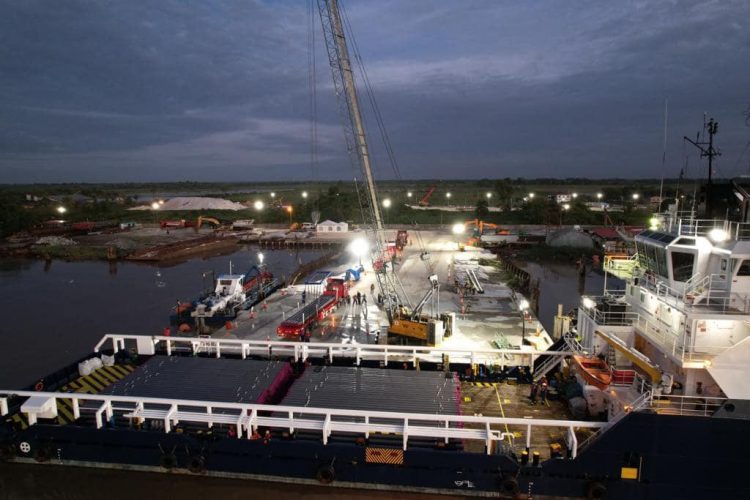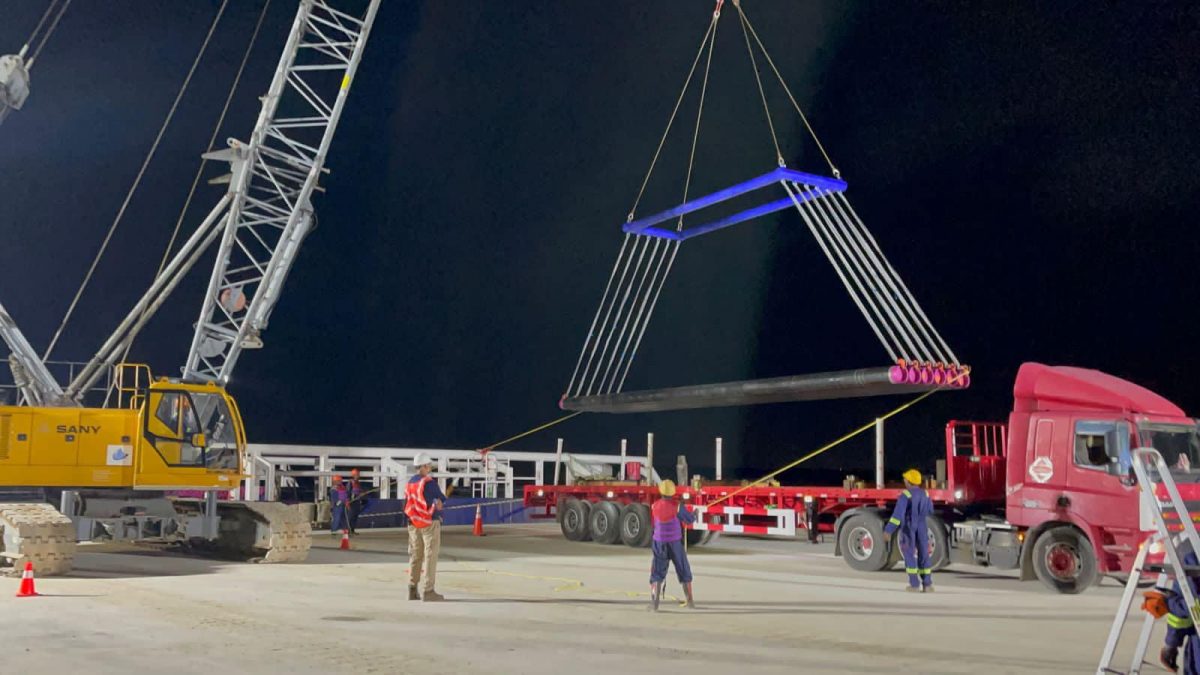Work on the estimated US$1 billion gas-to-energy project is forging ahead as pipes to be laid are in the country and will be installed from offshore coming inwards to Wales on the west bank of the Demerara River, even as administrative work on ExxonMobil’s Final Investment Decision wraps up.
“Work is continuing on the project and it will be delivered in the timeframe given. As you know, some of the pipes are here and will be at a lay-down yard to be taken out for installation. They are laying the pipes from offshore; so they are working inwards…,” Minister of Natural Resources Vickram Bharrat told the Sunday Stabroek.
Chief Executive Officer of the offshore support firm Gaico, Komal Singh, also yesterday updated that the pipes had arrived in the country and were being offloaded to pave the way for installation.

“Gaico Team continues to work around the clock to have the GTE (Gas to Energy) pipes off-loaded to pave the way for pipeline installation to commence,” he said in a Facebook post and posted pictures of the offloading process.
Sources told the Sunday Stabroek that while ExxonMobil has not yet made a Final Investment Decision on the project, there was no need for worry as the company has committed to the works and is finalising that process. “The work is going forward. There are still details to finalise… the FID is administrative but they [ExxonMobil] have committed their investment so there is no need for any worry,” a source close to the project informed.
“This is not your regular FID, the project is different. Agreements have been signed with them on the project, the contract to build has been awarded, the contract to lay the pipes awarded… so everything is going forward, everything is proceeding on schedule,” the source added.
In February of this year, ExxonMobil Country President, Alistair Routledge, said that a FID will be made with government after a review, but that preliminary works, such as the building of entry roads and bridges, have begun in the area proposed for the project, to ensure that it is delivered in the timeframe stipulated.
“We are in the review process with the Ministry of Natural Resources currently on the Field Development Plan and the update to the licence for the Liza field. Once we have gone through that step, we’d be able to make all the final commitments, Final Investment Decision around all the investments that are needed,” he stated.
But at a press conference last week, he said that government’s decision to take the issue of the extending of the licence for the Liza project to parliament influences when the FID is made, since until that is completed it could not do so.
“You may be aware that the early works have been proceeding as we committed to. We wanted to make sure that we did the early works in order to preserve the start-up schedule to be ready. The target is within 2024. What drives the Final Investment Decision is formalising all the detailed documents; the Field Development Plan, The revisions for the Liza field, Phase 1 and Phase 2… making sure all the commercial agreements are in place.”
He added, “And also, as the government has talked about, making sure that there is sufficient length of the project life to provide the gas to support the project. And so the government has decided that, in order to confirm the 10-year extension of the Liza production licence, that it feels that it needs to take that to the Parliament, and so that is the last step that is being worked on by the government.”
United Kingdom-based company, Bayphase, had assisted Guyana with Exxon’s proposed amendments to the Liza Field Development Plan (FDP) in order to facilitate the Gas-to-Energy initiative and last month, government had announced that the field development lifetime would be extended.
“Once that extension is granted, ExxonMobil and its Stabroek Block co-venturers – Hess Corporation and CNOOC – will go ahead with the preparation of their FID. “The project is built with a 20-year lifespan so once we complete the review, it will allow us to ensure that we have adequate gas coming in to generate enough power for Guyana,” Vice President Bharrat Jagdeo had told a press conference earlier this month.
Government has said that the project is expected to be completed and delivered by the fourth quarter of 2024, to achieve commissioning and testing of the 300 MW power plant by the end of 2024. It aims to employ approximately 800 workers during the peak construction stage and 40 full-time workers during the operation phase.
The project will be executed in three phases – construction, operation and decommissioning. It entails three aspects as well – an offshore pipeline which is approximately 220 kilometres of a subsea pipeline extending from new subsea tie-ins at the Destiny and Unity FPSOs in the Stabroek Block, to the proposed shore landing located approximately 3.5 kilometres west of the mouth of the Demerara River; onshore pipeline that is a continuation of the offshore line and extends about 25 kilometres from the landing site to the NGL (natural gas liquids) plant; and the NGL plant and associated infrastructure that will be located about 23 kilometres upstream from the mouth of the Demerara River on the west bank.
Both the Liza Destiny and Liza Unity floating production storage and offloading vessels, which are operating in the offshore Stabroek Block, have pre-installed facilities to allow for the export of the associated gas along with crude production.
Reinjection
Routledge has said that it has been determined that the gas can be exported without affecting the reinjection process to retrieve crude.
And like his company’s president, Darren Woods, who earlier this year pointed out that the company wants a win-win agreement for Guyana and itself, Routledge said that investing in a project that brings relief to power costs paid by citizens is just one way of ensuring that.
“For us, what motivates us on gas-to-energy is that we can clearly see the benefit for the country. We came to the country wanting to ensure that everyone benefits, clearly it needs to be a win-win-win. As our chairman said recently, it needs to be a win for the investors of course, otherwise, it doesn’t attract investment. There needs to be a win for the government and its ambition to develop the country and ultimately, for all the citizens of the country,” Routledge asserted.
Last week he echoed that position, saying that the gas being set aside for the GTE project was not one that is in excess but the company has worked out that it would not immediately affect the production of crude but however, will continue to assess it.
“At Liza, we use all the gas for fuel or reinjection to maximize liquids recovery which is what the Production Sharing Agreement (PSA) lays out as the right use of the gas. For the 50Mcf [50,000 cubic feet] a day, we are within the sort of error of margin on whether there will be or not an impact on the liquids recovery, and we believe there are certain things we can do to mitigate that over time. Which is why we don’t truly believe there is excess gas but we think it is right in the modeling that we do which is right at the edge of accuracy that we have,” he said.
“We are only three years into the life of operating a huge field and we are trying to make a forecast. Our agreement is close enough, on a risk basis, that we could make available the 50Mcf per day, and over time we will work out and assess what is the mitigation and what are other sources of gas we would find that would make sure we don’t affect, in any substantial way, the recovery of liquids from the fields,” he added.
Woods had said that the company’s position has always been one of having a “win-win-win proposition” across the board, as there “needs to be a win for the company. It needs to be a win for the Government of Guyana, and it needs to be a win for the people of Guyana.”
“And that’s what we’re seeing there, a lot of jobs, a lot of economic opportunity opening up in Guyana. We just – we’ve been working with the Guyanese government around a project to bring in gas power into the country. Lower emissions, more reliable. We’ve got work going on to help bring up some of the other social services in the country,” Woods had told the 2022 Q4 earnings call this month.
“So, I think people are seeing the progress. And the fact that we’re bringing this on sooner and at lower cost, I think, is a benefit to the government. They recognise the values coming faster than originally anticipated. So, it’s a – I think it’s a good story of the government, I think in ExxonMobil. We’ve got very good relationships, working very constructively. And, as I said, it’s a win-win-win proposition here, and we feel good about the progress we’re making.”
In December of last year, a US$759 million deal was inked between Guyana and US companies, CH4/Lindsayca, to build the 300 MW combined-cycle power plant and a natural gas liquids (NGL) facility.
At the core of the project is a pledge by the government that power charges to householders and industry will be halved when energy is produced.






